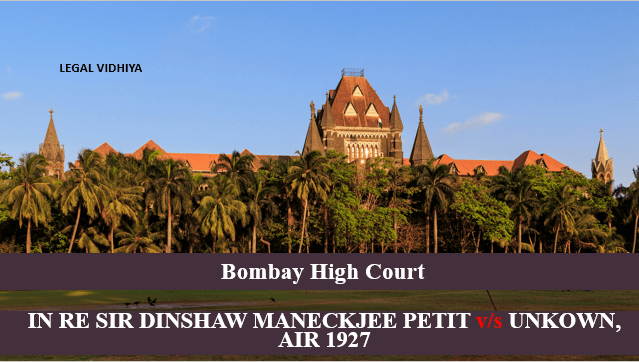
| Citation AIR 1927 Bom. 371 51 |
| Date of Judgement 29th November 1926 |
| Court Bombay High Court |
| Case Type Income Tax |
| Appellant Dinshaw Maneckjee Petit |
| Respondent Unknown |
| Bench Amberson Marten; KT Mr. Justice Kemp |
| Referred Sections 2(15), 3, 6, 12, 55, 56, 58 of Indian Income Tax Act, 1922 |
FACTS OF THE CASE
Sir Dinshaw Maneckjee petit was a wealthy man. He derives his income from dividend and interest. In order to evade tax he established four companies and used his income in these four companies as investment. He called them as his Family companies for convenience of reference but no member from his family had ever received any direct benefit from these companies.
The name of these four Companies were Petit Limited; the Bombay Investment Company Limited; the Miscellaneous Investment Limited; and the Safe Securities Limited. Each company has taken a particular part of Dinshaw income.
It was found that there were 498 shares of the companies out of which 254 were in his name, 200 were in the name of his wife and 13 were in the safe hands of nominees.
The counsel of Dinshaw argued that he was only the trustee of these family companies and the dividend and interest that he was having were of these family companies and the money credited in his account were the loan that he had taken from these companies. But in reality he didn’t pay any interest in cash.
But the Attorney General clearly stated that the disposition by the Dinshaw in favour of each company is a simulacrum, as is also a declaration of trust and the transactions made were only on paper but not in real. He subsequently claim that the sums in dispute represented taxable income of the Dinshaw in accordance with the Section 2(15), 3,6,12,55,56,and 58 of Indian Tax Act, 1922.
Apart from the entering into an agreement with Dinshaw the companies was not involved into any active business but holds 38 objects in its memorandum.
ISSUES BEFORE THE COURT
Whether the companies formed by Sir Dinshaw to be treated as a separate legal entity and whether the dispute that newly formed companies by Dinshaw was a simulacrum is valid?
JUDGEMENT ANALYSIS
In this Case the Court stated that the company was acknowledged under the legislature so the company could not be regarded as a simulacrum just because it was a One Person Company.
The decision of the court solely depend upon the merits of Salomon v. Salomon Case in which it was held that a separate legal entity does not give freedom to treat every alleged transaction as a real transaction. The Bombay High court stated that the transaction made by Dinshaw and the family companies were of the ‘Window Dressing’ (misleading representation) nature.
The court on further investigation found that there was neither the document of the company which can show that there was a formal transaction, nor there was delivery of share certificates and even the original documents didn’t bear the registration mark.
The Court further cited the example of Inland Revenue Commissioners v. Samson (1921). In this case an alleged loan had been undoubtedly paid by Mr. Samson to his family companies and it was not a mere acting to avoid the taxes. The court stated that just by giving or taking loan from family companies would result it to a simulacrum company. The company that were by Sir Dinshaw does not carry any business and these company were established to evade taxes by transferring the dividend and interest of the Dinshaw as a pretended loan.
So it was declared by the court that these company were founded only to evade supertax on his taxable income and the company were nothing but Dinshaw himself and the company cannot be regarded as a separate legal entity of Sir Dinshaw.
The Judgement given by the Bombay High Court was accurate as any company founded to evade the tax by transferring the dividend and interest to Dinshaw cannot be regarded as a separate legal entity and it will not provide no protection in cases related to protection of revenue.
REFERENCE
https://www.lawyersclubindia.com
https://www.legalserviceindia.com
This Article is written by Manvi Verma of The Law School, University of Jammu and an intern at Legal Vidhiya.




0 Comments